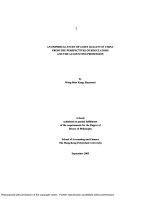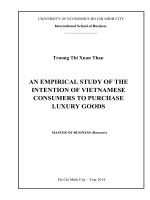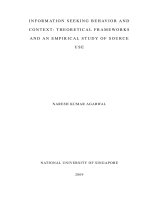An Empirical Study Of The Use Of Cost Accounting Systems In Libyan Agricultural Firms
Bạn đang xem bản rút gọn của tài liệu. Xem và tải ngay bản đầy đủ của tài liệu tại đây (1.22 MB, 46 trang )
AN EMPIRICAL STUDY OF THE USE OF COST ACCOUNTING
SYSTEMS IN LIBYAN AGRICULTURAL FIRMS
ABOBAKER M ABDURAHMAN FATAH
DOCTOR OF PHILOSOPHY
UNIVERSITI UTARA MALAYSIA
July 2013
AN EMPIRICAL STUDY OF THE USE OF COST ACCOUNTING SYSTEMS IN
LIBYAN AGRICULTURAL FIRMS
By
ABOBAKER M. ABDURAHMAN FATAH
Thesis Submitted to
Othman Yeop Abdullah Graduate School of Business,
Universiti Utara Malaysia,
in Fulfillment of Requirements for the Degree of Doctor of Philosophy
ii
iii
PERMISSION TO USE
In presenting this thesis in fulfillment of the requirements for a Post Graduate degree
from the Universiti Utara Malaysia (UUM), I agree that the Library of this university
may make it freely available for inspection. I further agree that permission for copying
this thesis in any manner, in whole or in part, for scholarly purposes may be granted by
my supervisor(s) or in their absence, by the Dean of Othman Yeop Abdullah Graduate
School of Business where I did my thesis. It is understood that any copying or
publication or use of this thesis or parts of it for financial gain shall not be allowed
without my written permission. It is also understood that due recognition shall be given
to me and to the UUM in any scholarly use which may be made of any material in my
thesis.
Request for permission to copy or to make other use of materials in this thesis in whole
or in part should be addressed to:
Dean of Othman Yeop Abdullah Graduate School of Business
Universiti Utara Malaysia
06010 UUM Sintok
Kedah Darul Aman
iv
ABSTRACT
The agricultural sector is one of the important contributors to Libyan economy. Most of
the agricultural firms in Libya are government-owned and recently compelled to
compete with foreign companies. Available literature shows that one of the challenges
faced by the government-owned agricultural firms in Libya is the ever-increasing
production costs. This results in the reduction of the country’s wheat production as the
market price decreases. The importance of understanding the impact of the increasing
costs motivates the thesis to investigate the nature of cost accounting systems in the
agricultural firms which receives less attention than the manufacturing sector.
The main objective of the thesis is to examine and understand the current practice of cost
accounting systems in Libyan agricultural firms. Using a mixed-method explanatory
design, three instruments were used to collect the data, namely a questionnaire-based
survey, interviews and documentation analysis. A total of 57 questionnaires were
distributed to government-owned agricultural firms in Libya. In addition, interviews
with management accountants and documentation analysis were conducted to support
the findings.
A framework was developed based on the survey findings, which includes the influence
of six contingent factors on the use of cost accounting systems. This study found that the
firm size, cost structure, importance of cost information and legal obligation positively
and significantly influence Libyan agricultural firms to use cost accounting systems. The
influence of both competition and product diversity, on the other hand are not
significant. The results of the study are expected to have implications for Libyan
agricultural firms regarding the importance of using cost accounting systems in
managing their production costs.
Keywords: Libya, traditional costing, cost accounting systems, agricultural firms.
v
ABSTRAK
Sektor pertanian merupakan salah satu penyumbang utama kepada ekonomi Libya.
Kebanyakan firma berasaskan tani di Libya adalah milik kerajaan, tetapi sejak akhirakhir ini telahmemaksa firma tempatanuntukbersaing dengan firma-firma asing. Kajian
terdahulu menunjukkan salah satu cabaran yang dihadapi oleh syarikat berasaskan tani
milik kerajaan di Libya adalah kos pengeluaran yang semakin meningkat setiap tahun.
Hal ini memberikan kesan terhadap pengeluaran gandum dalam negara kerana nilai
pasaran yang menyusut disamping kos pengeluaran yang semakinmeningkat.
Kepentingan dalam memahami kesan peningkatan kos pengeluaran telah mendorong
tesis ini untuk mengkaji sistem perakaunan kos dalam firma berasaskan tani di Libya
yang kurang mendapat perhatian berbanding dengan sektor perkilangan.
Objektif utama kajianini adalah untuk meneliti dan memahami amalan semasa sistem
perakaunan kos dalam firma berasaskan tani di Libya. Dengan menggunakan reka
bentuk penjelasan, tiga kaedah telah digunakan untuk mengumpul data, iaitu soal
selidik, temu bual, dan analisis dokumentasi. Sebanyak 57 borang soal selidik telah
dihantar kepada firma berasaskan tani milik kerajaan di Libya. Di samping itu, kaedah
temubual dan analisis dokumentasi juga dijalankan untuk menyokong dapatan kajian.
Satu kerangka kerja telah dibentuk berdasarkan dapatan kajian, termasuk pengaruh
enam faktor penentu ke atas penggunaan sistem perakaunan kos. Kajianini mendapati
saiz firma, struktur kos, kepentingan maklumat kos dan kewajipan mematuhi undangundang adalah positif dan signifikan dalam mempengaruhi amalan sistem perakaunan
kos bagi firma berasaskan tani di Libya. Tahap persaingan dan kepelbagaian produk
didapati tidak signifikan. Hasil dapatan kajianini dijangka akan memberikan implikasi
positif terhadap firma berasaskan tani di Libya tentang kepentingan menggunakan
sistem perakaunan kos terutama dalam pengurusan kos pengeluaran.
Kata kunci: Libya, pengekosan tradisional, sistem perakaunan kos, firma berasaskan
tani.
vi
ACKNOWLEDGEMENT
First of all, I would like to state that this PhD thesis has been completed because of the
supreme mercy of Allah and the support, supervision, and advice of many people. I
would like to thank Allah for guiding me in my PhD study, and I would also like to
express my gratitude to my supervisor, Dr Rosliza Mat Zin. Her guidance was essential
to my successful completion of this PhD thesis. I also want to thank Dr Che Zuriana
Muhammad Jamil and Dr Zarifah Abdullah, who gave me valuable comments during the
discussion of the research proposal, as well as all the Sultanah Bahiyah library staff, who
were very helpful and humble. My thanks are also due to all the Universiti Utara
Malaysia employees who facilitate the education process for the students.
Furthermore, I would like to thank the Libyan agricultural firms in the public sector that
assisted me in fulfilling this PhD thesis by responding to the research questionnaire,
giving me some of their time to conduct interviews, and providing me with some
documents.
I want to thank the Libyan Government, especially the Education Ministry and Sebha
University, for giving me the opportunity and sponsoring me during my studies at
Universiti Utara Malaysia.
Finally, I want to thank all my family members, my parents (Mohamed and Safia), my
sisters, my brothers, my wife, Fatma, and my sons, for their encouragement and support.
I owe special thanks to my brother, Logman, who helped me greatly during my
fieldwork.
vii
Table of Contents
Title
Page
TITLE PAGE
i
CERTIFICATION OF THESIS WORK
ii
PERMISSION TO USE
iv
ABSTRACT
v
ABSTRAK
vi
ACKNOWLEDGEMENT
vii
TABLE OF CONTENTS
viii
LIST OF TABLES
xvi
LIST OF FIGURES
xix
LIST OF ABBREVIATIONS
xx
CHAPTER ONE: INTRODUCTION
1
1.1
Introduction
1
1.2
Background of the Study
1
1.3
Problem Statement
6
1.4
Research Objectives
12
1.5
Research Questions
13
1.6
Significance of the Study
13
1.7
Scope and Limitations of the Study
14
1.8
Research Process
14
1.9
Structure of the Thesis
16
viii
CHAPTER TWO: OVERVIEW OF AGRICULTURE IN LIBYA
18
2.1
Introduction
18
2.2
Definition of Agriculture
18
2.3
Agricultural History in Libya
20
2.4
Agricultural Firms in Libya
24
2.5
Organizational Structure in Libyan Agricultural Firms
28
2.6
Agricultural Production Processes for Plantation
33
2.6.1
Maintenance
34
2.6.2
Tilling Process
35
2.6.3
Sowing Process
37
2.6.4
Watering, Fertilizing, and Pest Control
37
2.6.5
Harvesting
39
2.6.6
Cleaning, Filling, and Packaging
40
2.7
Agricultural Expenditure in Libya
40
2.8
Agricultural Gross Domestic Product (GDP) Share in Libya’s Total GDP
41
2.9
Arable Land in Libya
42
2.10
Agricultural Production in Libya
44
2.11
Cost Accounting Systems in Libyan Agricultural Firms
47
2.12
Summary
51
CHAPTER THREE: LITERATURE REVIEW
52
3.1
Introduction
52
3.2
Overview of Cost Accounting Systems
53
3.2.1
53
Concept and Definition of Cost Accounting Systems
ix
3.3
3.4
3.5
3.2.1.1
Elements of Costs
55
3.2.1.2
Classification of Costs
57
3.2.2
History of Cost Accounting Systems
59
3.2.3
Allocation of Overhead Costs
64
3.2.4
Significance of Cost Accounting Systems
66
3.2.5
Cost Accounting Systems
68
Review of the Literature Related to Cost Accounting Systems
77
3.3.1
Cost Accounting Systems in the Manufacturing Sector
77
3.3.2
Cost Accounting Systems in Service Firms
97
3.3.3
Cost Accounting Systems in Agricultural Firms
107
Factors Influencing the Use of Cost Accounting Systems
119
3.4.1
Size
119
3.4.2
Level of Competition
121
3.4.3
Product Diversity
123
3.4.4
Cost Structure
125
3.4.5
Importance of Cost Information
126
3.4.6
Legal Obligation
128
Summary
134
CHAPTER FOUR: RESEARCH METHODOLOGY
135
4.1
Introduction
135
4.2
Research Design
135
4.2.1
Research Questions
140
4.2.2
Research Framework
142
x
4.2.3
4.2.4
Research Hypotheses
145
4.2.3.1
Size
145
4.2.3.2
Level of Competition
147
4.2.3.3
Product Diversity
148
4.2.3.4
Cost Structure
149
4.2.3.5
Importance of Cost Information
150
4.2.3.6
Legal Obligation
151
Data Collection
151
4.2.4.1
Questionnaire Design
153
4.2.4.1.1
Reliability
156
4.2.4.1.2
Validity
157
4.2.4.2
Interviews
159
4.2.4.3
Documentation Analysis
162
4.3
Research Population and Sampling
163
4.4
Measurement of the Variables
165
4.4.1
Independent Variables
165
4.4.1.1
Size
165
4.4.1.2
Cost Structure
166
4.4.1.3
Level of Competition
166
4.4.1.4
Product Diversity
167
4.4.1.5
Importance of Cost Information
168
4.4.1.6
Legal Obligation
168
4.4.2
Dependent Variable
169
xi
4.5
4.6
Data Analysis
171
4.5.1
Questionnaire Analysis
171
4.5.2
Interview Data Analysis and Documentation Analysis
175
Summary
176
CHAPTER FIVE: RESEARCH FINDINGS
179
5.1
Introduction
179
5.2
Analysis of the Survey Responses
179
5.2.1
Response Rate
179
5.2.2
Test of Non-Response Bias
180
5.3
Descriptive Analysis
182
5.3.1
Profile of the Respondents
182
5.3.1.1
Gender
184
5.3.1.2
Experience
184
5.3.1.3
Level of Education
185
5.3.1.4
Qualifications
185
5.3.1.5
Working Years in the Firm
186
5.3.1.6
Activity Type
186
5.3.1.7
Area
186
5.3.1.8
Number of Employees
187
5.3.1.9
Cost Accounting Systems
187
5.3.2
5.4
Descriptive Statistics for Continuous Variables
187
Screening the Data
190
5.4.1
190
Detecting the Errors in the Categorical Data
xii
5.5
5.4.2
Detecting the Errors in the Continuous Data
191
5.4.3
Missing Data
192
5.4.4
Checking for Outliers
192
Assumptions Underlying Statistical Regressions
193
5.5.1
Assessing Normality
193
5.5.2
Multicollinearity
195
5.5.3
Singularity
197
5.6
Measurement Codes
197
5.7
Factor Analysis
199
5.7.1
Factor Analysis for the Level of Competition
200
5.7.2
Factor Analysis for Product Diversity
201
5.7.3
Factor Analysis for the Importance of Cost Information
202
5.7.4
Factor Analysis for Legal Obligation
203
5.7.5
Factor Analysis for the Uses of Cost Information
204
5.8
Bivariate Correlation
205
5.9
Multiple Regressions
208
5.9.1
209
5.10
Evaluating the Model
One-Way Anova (Post-Hoc Test)
212
5.10.1 Size
212
5.10.2 Cost Structure
213
5.11
Hypothesis Testing
214
5.12
Interview Data Analysis
219
5.13
Summary
236
xiii
CHAPTER SIX: DISCUSSION
238
6.1
Introduction
238
6.2
The Use of CASs in Libyan Agricultural Firms
238
6.3
Extent of CAS Usage in Libyan Agricultural Firms
246
6.4
Factors That Influence the Use of CASs in Libyan Agricultural Firms
248
6.4.1
Size
249
6.4.2
Level of Competition
253
6.4.3
Product Diversity
256
6.4.4
Cost Structure
258
6.4.5
Importance of Cost Information
261
6.4.6
Legal Obligation
263
6.5
Overhead Cost Allocation
264
6.6
Determining the Product Costs
270
6.7
Summary
274
CHAPTER SEVEN: CONCLUSION
275
7.1
Introduction
275
7.2
Overview of the Study
275
7.3
Theoretical Contributions of the Study
284
7.4
Methodological Contributions of the Study
287
7.5
Practical Contributions of the Study
288
7.6
Limitations of the Study
290
7.7
Recommendations for Future Research
291
7.8
Conclusion
294
xiv
REFERENCES
296
APPENDICES
319
Appendix 1 Questionnaire
319
Appendix 2 Semi-Structured Interview Questions
333
Appendix 3 Descriptive Statistics
334
Appendix 4 Test of Non-Response Bias
342
Appendix 5 Checking the Errors of the Continuous Variables’ Ranges
345
Appendix 6 Test of Normality: All Variables
347
Appendix 7 Correlation Matrix
352
Appendix 8 Factor Analysis
353
Appendix 9 Regression Analysis
363
Appendix 10 Permission Letter from Universiti Utara Malaysia
365
Appendix 11 Translated Permission Letter from Universiti Utara Malaysia
366
xv
List of Tables
Table
Page
Table 2.1
Definitions of the Key Terms Used
18
Table 2.2
Libyan Agricultural Firms
27
Table 2.3
Actual Expenditure during the Period from 2006 to 2009
41
Table 2.4
Agricultural (GDP) Share in the Libyan Total GDP
42
Table 2.5
Most Important Farm Products during the Period from 1985 to 2002
46
Table 2.6
Most Important Farm Products during the Period from 2006 to 2009
47
Table 3.1
Definitions of the Key Terms Used
52
Table 3.2
Summary of the Literature Review
130
Table 4.1
Cronbach’s Alpha and the Degree of Reliability
157
Table 4.2
Level of Competition Measurement Items
167
Table 4.3
Product Diversity Measurement Items
167
Table 4.4
Importance of Cost Information Measurement Items
168
Table 4.5
Legal Obligation Measurement Items
169
Table 4.6
Uses of Cost Information Measurement Items
170
Table 4.7
Definition of the Variables and Measurements
170
Table 5.1
Profile of the Respondents
182
Table 5.2
Agricultural Firms’ Revenues
188
Table 5.3
Cost Structure
188
Table 5.4
Level of Competition
189
Table 5.5
Product Diversity
189
Table 5.6
Importance of Cost Information
189
xvi
Table 5.7
Legal Obligation
190
Table 5.8
Uses of Cost Information
190
Table 5.9
Checking the Errors in the Categorical Data
191
Table 5.10 Values of Tolerance and VIF
196
Table 5.11 Detailed List of All the Items
198
Table 5.12 Factor Analysis Results for the Level of Competition
201
Table 5.13 Factor Analysis Results for Product Diversity
202
Table 5.14 Factor Analysis Results for the Importance of Cost Information
203
Table 5.15 Factor Analysis Results for Legal Obligation
204
Table 5.16 Factor Analysis Results for the Uses of Cost Information
205
Table 5.17 Pearson Correlation Coefficient
206
Table 5.18 Correlation Strength between the Variables
208
Table 5.19 Beta Values
209
Table 5.20 Model Summary
210
Table 5.21 Anova
211
Table 5.22 Values of T and P
211
Table 5.23 Test of Homogeneity of Variances for Size
213
Table 5.24 Anova for Size
213
Table 5.25 Test of Homogeneity of Variances for Cost Structure
214
Table 5.26 Anova for Cost Structure
214
Table 5.27 Summary of Hypotheses Testing
219
Table 5. 22 Interviewees’ Information
220
Table 5. 29 Interviewees’ Position
222
xvii
Table 5.30 Interviewees’ Level of Education
222
Table 5.31 Interviewees’ Qualifications
222
Table 5.32 Establishment of the Firms
222
Table 5.33 Number of Employees
223
Table 5.34 Type of Products
223
Table 5.35 Firms’ Strategy
224
Table 5.36 Size of Agricultural Firms’ Land
224
Table 5.37 Cost Accounting System Departments
225
Table 5.38 Summary of the Responses regarding Determining the Product Cost
227
Table 5.39 Uses of Cost Information
228
Table 5.40 Stock Methods
229
Table 5.41 Product Pricing
230
Table 5.42 Allocation of Overhead Costs
231
Table 5.43 Usefulness of Cost Information
232
Table 5.44 Transfer Pricing
233
Table 5.45 Depreciation Methods
233
Table 5.46 Significance of Cost Accounting Systems in Libyan Agricultural Firms
234
Table 5.47 Difficulties Facing Libyan Agricultural Firms in Using Cost
235
Accounting Systems
Table 5.48 Usefulness of Cost Accounting Regarding Scarce Resources
xviii
236
List of Figures
Figure
Page
Figure 1.1
Research Process
15
Figure 2.1
Agricultural Activities
20
Figure 2.2
Agricultural Firms’ Location (Green Areas)
24
Figure 2.3
Organizational Structure
30
Figure 2.4
Irrigation Department in Barjoj Firm
31
Figure 2.5
Irrigation Department in Deeseh Firm
32
Figure 2.6
Plantation Process Stages
34
Figure 2.7
Tillage Process
36
Figure 2.8
Sowing Process
37
Figure 2.9
Pivot Irrigation System
38
Figure 2.10
Location of Libya
43
Figure 2.11
Cost Elements in Libyan Agricultural Firms
50
Figure 3.1
Target Costing Design Stages
72
Figure 3.2
Backflush Costing System
73
Figure 3.3
Activity-Based Costing Allocation Stages
76
Figure 4.1
Research Design
139
Figure 4.2
Research Framework
145
Figure 4.3
Instruments for Data Collection
153
Figure 6.1
Suggested Framework for the Implementation of ABC
268
xix
List of Abbreviations
ABC
Activity-Based Costing
AIAEE
Association of International Agricultural Extension Education
CAS
Cost Accounting System
CASB
American Cost Accounting Standard Board
FA
Factory Automation
FAO
Food and Agricultural Organization
FMS
Flexible Manufacturing Systems
GAO
Government Accountability Office
GDP
Gross Margin Product
ICWA
Institute of Cost and Works Accountants
IMF
International Monetary Fund
JIT
Just In Time
JOC
Job Order Costing
LCC
Life Cycle Costing
MAPs
Management Accounting Practices
MAS
Management Accounting System
MOH
Manufacturing Overhead Costs
PC
Process Costing
SC
Standard Costing
SMEs
Small and Medium Enterprises
SPSS
Statistical Package for the Social Sciences
TC
Target Costing
xx
CHAPTER ONE
INTRODUCTION
1.1 Introduction
This chapter aims to provide a general introduction to this thesis and includes seven
sections. The first section briefly explains the importance of cost accounting systems.
The second section explains the problem statement. The third and fourth sections present
the research objectives and research questions, respectively. The last three sections
discuss the significance of the study, the scope of the study, and finally the structure of
the thesis.
1.2 Background of the Study
Accounting researchers have argued that the development of cost accounting systems is
associated with the development of the industrial sector. Earlier researchers argued that
the Industrial Revolution, which happened in the eighteenth century, was the starting
point for cost accounting systems (Garner, 1947; Mepham, 1988; Fleischman & Parker,
1991; Fleischman & Tyson, 1993; Ning, 2005). Connecting the development of cost
accounting systems with the Industrial Revolution led to most earlier researchers
concentrating on the manufacturing sector’s cost accounting systems (Karmarkar,
Lederer, & Zemmerman, 1989; Fleischman & Tyson, 1993; Cropper & Drury, 1996;
Brierley, Cowton, & Drury, 2001a; Fullerton & Mcwatters, 2004). A few researchers,
such as Ittner and Larcker (2002) and Hume-Schwarz (2007), have claimed that cost
accounting should be named manufacturing accounting because it serves manufacturing
businesses and the production of commodities. Ittner and Larcker (2002) supported the
assertion that cost accounting systems are widely used in manufacturing organizations,
1
The contents of
the thesis is for
internal user
only
References
Abd-Almajeed, A. (2007). Industrial river. Retrieved from />Abdel-Al, S. F., & Mclellan, J. D. (2011). Management accounting practices in Egypt –
A transitional economy country. Management Accounting – Business &
Management, 18(2), 105–120.
Abdel-Kader, M., & Luther, R. (2008). The impact of firm characteristics on
management accounting practices: A UK based empirical analysis. British
Accounting Review, 40, 2–27.
Abernethy, M. A., Lillis, A. M., Brownell, P., & Carter, P. (2001). Product diversity and
costing system design choice: Field study evidence. Management Accounting
Research, 12, 261–279.
Abidar, A., & Laytimi, A. (2005). National Agriculture Policy – Tripoli, Libya. 2005.
Abrahamson, E. (1991). Managerial fads and fashions: The diffusion and rejection of
innovations. Academy of Management Review, 16(3), 566–612.
Agribank. (2010). Establishment of Agribank. Retrieved from />Ahmad, F. (2010). The stolen head from exhibition Dutch. Retrieved from />Albyati, M. M. (2005). Statistical data analysis using SPSS. Unpublished manuscript,
Oman.
Aljazawe, A. (2006). Evaluation of cost accounting in farming. Bangaze: Academy of
High Studies.
296
Alleyne, P., & Weekes-Marshall, D. (2011). An exploratory study of management
accounting practices in manufacturing companies in Barbados. International Journal
of Business and Social Science, 2(9), 49–58.
Al-Masri, M. (1997). Libya country paper. Retrieved from />Al-Omiri, M., & Drury, C. (2007). A survey of factors influencing the choice of product
costing systems in UK organizations. Management Accounting Research, 18, 399–
424.
Alsabbag, A. A., & Alseheri, A. M. (1992). Studies in agricultural accounting. Gharyan:
Faculty of Accounting in Gharyan.
Altahir, S. A. M. (2008). Project Deeseh productive. Retrieved from />Amara, M., Kalefa, M., & Alsaheeri, A. H. (1992). Modern studies in actual cost
accounting (1st ed.). Garyan: Garyan University.
Anderson, S. W. (1995). A framework for assessing cost management system changes:
The case of activity based costing implementation at General Motors, 1986–1993.
Retrieved from Anderson-1995Aframework....pdf
Argilés, J. M., & Slof, E. J. (2001). New opportunities for farm accounting. Retrieved
from />Argilés, J. M., & Slof, E. J. (2003). The use of financial accounting information and firm
performance: An empirical quantification for farms. Accounting and Business
Research, 33(4), 251–273.
297

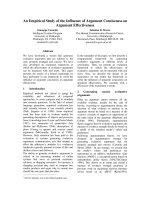

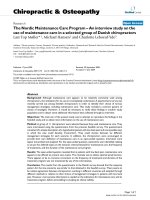
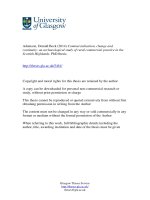
![chung - 2004 - selective mandatory auditor rotation and audit quality - an empirical investigation of auditor designation policy in korea [mar]](https://media.store123doc.com/images/document/2015_01/06/medium_bpj1420548143.jpg)
